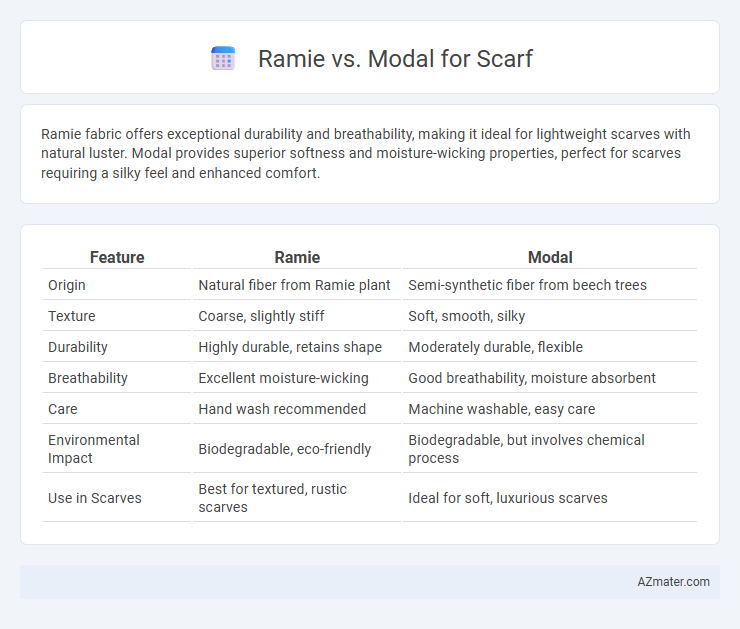Ramie fabric offers exceptional durability and breathability, making it ideal for lightweight scarves with natural luster. Modal provides superior softness and moisture-wicking properties, perfect for scarves requiring a silky feel and enhanced comfort.
Table of Comparison
| Feature | Ramie | Modal |
|---|---|---|
| Origin | Natural fiber from Ramie plant | Semi-synthetic fiber from beech trees |
| Texture | Coarse, slightly stiff | Soft, smooth, silky |
| Durability | Highly durable, retains shape | Moderately durable, flexible |
| Breathability | Excellent moisture-wicking | Good breathability, moisture absorbent |
| Care | Hand wash recommended | Machine washable, easy care |
| Environmental Impact | Biodegradable, eco-friendly | Biodegradable, but involves chemical process |
| Use in Scarves | Best for textured, rustic scarves | Ideal for soft, luxurious scarves |
Introduction to Ramie and Modal Fabrics
Ramie is a natural fiber derived from the stalks of the Chinese nettle plant, valued for its strength, durability, and lustrous appearance, making it an excellent choice for lightweight scarves with a crisp texture. Modal, a semi-synthetic fabric made from beech tree pulp, offers exceptional softness, breathability, and moisture-wicking properties, providing a smooth and comfortable feel ideal for delicate scarf designs. Both fabrics combine unique qualities that influence comfort, aesthetics, and longevity in scarf production.
Origin and Production Processes
Ramie is a natural fiber derived from the stalks of the Chinese nettle plant, primarily cultivated in China and the Philippines, where the fibers undergo a labor-intensive process of harvesting, retting, and degumming to extract the strong, lustrous threads used in scarves. Modal is a semi-synthetic fiber made from beech tree cellulose, predominantly produced in Europe through a chemical-intensive process involving dissolving pulp and regeneration into smooth, soft fibers ideal for lightweight, breathable scarves. The natural extraction of ramie preserves its coarse texture and durability, whereas modal's industrial production yields a silky, flexible fabric favored for its moisture-wicking qualities.
Texture and Feel: Ramie vs Modal
Ramie fabric offers a crisp, textured feel with a natural luster, making scarves lightweight and breathable yet slightly coarse compared to Modal. Modal provides a smooth, silky texture that feels exceptionally soft and luxurious against the skin, ideal for scarves needing gentle draping and high comfort. The choice between Ramie and Modal scarves hinges on preferences for a sturdy, textured finish versus a smooth, silky touch.
Breathability and Moisture-Wicking Properties
Ramie fibers provide excellent breathability and are highly absorbent, making them ideal for scarves that keep you cool in warm weather. Modal, made from beech tree pulp, excels in moisture-wicking by quickly drawing sweat away from the skin and drying faster than cotton. Both materials offer comfort, but modal tends to be softer and more effective at managing moisture, while ramie offers superior airflow and durability.
Durability and Longevity Comparison
Ramie fabric exhibits exceptional durability due to its strong cellulose fibers, making it resistant to wear and tear for scarves subjected to frequent use. Modal, derived from beech tree pulp, offers softness and flexibility but tends to experience fiber weakening over extended periods, reducing its longevity in comparison. Scarves made from ramie maintain structural integrity and vibrant appearance longer, while modal requires more delicate care to preserve its lifespan.
Environmental Impact and Sustainability
Ramie fibers, derived from a naturally growing plant, offer exceptional biodegradability and require fewer pesticides and water compared to Modal, which is produced from beech tree cellulose via energy-intensive chemical processing. Modal, while partially renewable, often relies on commercial forestry practices that can impact biodiversity and carbon sequestration negatively. Choosing ramie for scarves supports lower environmental impact through sustainable cultivation and reduced chemical use, making it a more eco-friendly textile option.
Color Retention and Dyeing Capabilities
Ramie offers excellent color retention due to its natural luster and strong fibers, which absorb dyes deeply, resulting in vibrant, long-lasting colors ideal for scarves. Modal, a semi-synthetic fabric made from beech tree pulp, provides superior dyeing capabilities with bright, rich hues but tends to fade faster over time compared to ramie. For scarves, ramie's durability and resistance to fading make it a preferred choice for maintaining vivid color through repeated washings and wear.
Comfort and Hypoallergenic Qualities
Ramie scarves offer superior breathability and moisture-wicking properties, making them comfortable for sensitive skin and reducing irritation risks. Modal scarves provide a silky softness and excellent drape while being naturally hypoallergenic, ideal for individuals prone to allergies. Both fibers promote comfort, but modal's smooth texture often feels gentler against the skin compared to the slightly coarser ramie.
Care and Maintenance Requirements
Ramie scarves require gentle hand washing with mild detergent and air drying to maintain their natural luster and prevent fiber weakening. Modal scarves, known for their softness and durability, can often be machine washed on a gentle cycle and tumble dried on low heat without significant damage. Proper care for both fabrics ensures longevity, but ramie's delicate nature demands more cautious handling compared to the more resilient modal.
Which is Better for Scarves: Ramie or Modal?
Ramie and modal fibers each offer unique advantages for scarves, with ramie known for its exceptional breathability and natural luster, making it ideal for lightweight, summer scarves that stay crisp and cool. Modal, a type of semi-synthetic cellulose fiber, excels in softness, moisture-wicking, and drape, providing luxurious comfort and durability for all-season wear. When choosing between ramie and modal for scarves, consider ramie's strength and eco-friendliness for a textured, natural look, while modal's smoothness and flexibility cater to those seeking silky softness and vibrant color retention.

Infographic: Ramie vs Modal for Scarf
 azmater.com
azmater.com